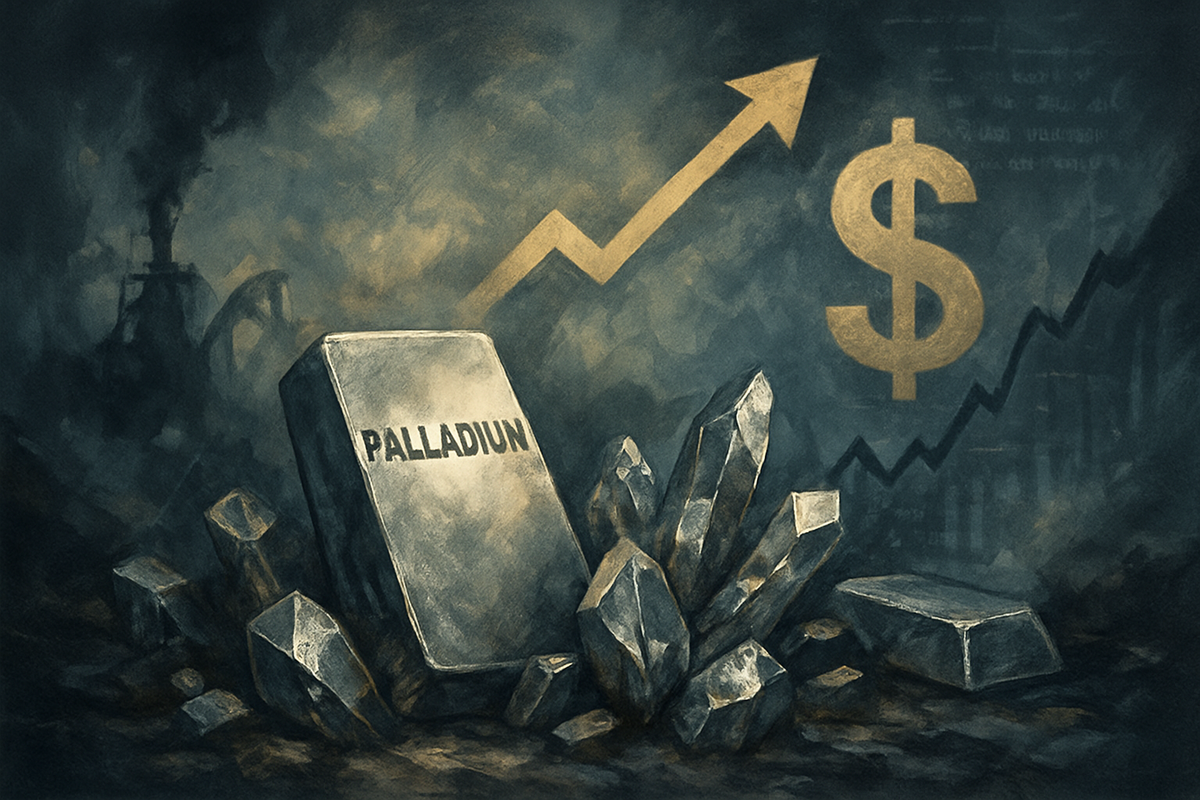
New York, NY – November 19, 2025 – The palladium market, a volatile cornerstone of the precious metals complex, finds itself at a critical juncture. While 2025 has largely been a year of surprising rallies for the industrial metal, recent weeks leading up to mid-November have seen notable short-term dips, with prices retreating from their October peaks. This recent volatility is being closely watched by market participants, who are weighing the immediate pressures of a strengthening US dollar and upcoming economic data against the backdrop of long-term structural shifts in the automotive industry.
The U.S. dollar's renewed strength, fueled by a more hawkish stance from the Federal Reserve and diminished hopes for aggressive interest rate cuts, has made dollar-denominated commodities like palladium more expensive for international buyers. Simultaneously, a mixed bag of global economic data, particularly from key industrial powerhouse China, has raised concerns about overall demand for metals. These macroeconomic headwinds are contributing to a cautious sentiment, even as palladium's year-to-date performance remains robust, prompting a re-evaluation of its trajectory in the coming months.
A Turbulent Trajectory: Unpacking Palladium's Recent Swings
Palladium, which once commanded prices over $3,000 per ounce in early 2022, has been on a rollercoaster ride. After a significant downturn from its peak, 2025 initially brought a surprising resurgence, with the metal rallying impressively. By October 8, 2025, palladium had surged by as much as 41% year-to-date, peaking around $1,655 per ounce in mid-October. However, the period around November 2025 has introduced fresh volatility, marking a retreat from these highs.
Specifically, on November 14, 2025, palladium experienced a notable plunge, dropping by 2.98% to a New York Spot Price of $1,368.00 per ounce, continuing a downward trend from its mid-October peak. By November 19, 2025, the metal was trading around $1,442 USD/t.oz, reflecting a 4.47% decrease over the past month and a 0.3% drop on the day itself. This short-term pullback is a stark reminder of palladium's inherent sensitivity to broader economic and currency movements.
A significant factor in this recent downturn has been the strengthening US Dollar Index, which rose by 0.6% to 97.8 points by late September and maintained a near three-month high into November. A stronger dollar makes palladium more costly for holders of other currencies, dampening demand. Concurrently, a more hawkish tone from U.S. Federal Reserve officials has tempered expectations for future interest rate cuts, further bolstering the dollar and contributing to a widespread decline across precious metals. Beyond currency dynamics, disappointing economic data, particularly from China, has fueled concerns over global industrial demand, especially for metals. Initial market reactions have seen aggressive profit-taking by short-term futures traders, compounding the selling pressure. Adding to the complexity, a U.S.-China trade agreement and the reopening of the U.S. government after a prolonged shutdown have reduced safe-haven demand, impacting all precious metals.
Winners and Losers in the Volatile Palladium Market
The recent volatility and the underlying long-term structural changes in the palladium market create distinct winners and losers among public companies.
Palladium Miners: Facing Headwinds Companies heavily invested in palladium mining are directly exposed to price fluctuations, with sustained lower prices eroding their profitability and stock valuations.
- Nornickel (MCX:GMKN), the world's largest palladium producer (Russia), is highly sensitive to these price shifts. Lower palladium revenues directly impact its bottom line, potentially leading to a decline in its stock price and a re-evaluation of investment plans.
- Impala Platinum Holdings (JSE:IMP, OTCQX:IMPUF) (Implats), a major South African PGM producer, also sees its revenues and margins squeezed by palladium's decline. The company has already been implementing cost-cutting measures and scaling back expansion due to slumping earnings. The planned closure of its Impala Canada's Lac des Iles mine by May 2026 further highlights strategic adjustments in response to market conditions.
- Sibanye-Stillwater (NYSE: SBSW), with significant palladium exposure from its U.S. Stillwater and East Boulder mines, faces similar challenges. These operations are heavily weighted towards palladium, making them particularly vulnerable to price drops, which have already forced production curtailments and layoffs in 2024.
- Anglo American Platinum (OTCPK:ANGPY) (Amplats), another leading South African PGM group, will see a negative impact on its overall PGM basket price, affecting profitability from its palladium-rich ore bodies.
- Generation Mining (TSX:GENM), a Canadian company with the Marathon copper-palladium project, finds the economic viability and funding prospects of its flagship project challenged by lower palladium prices.
Automotive Manufacturers: Benefiting from Lower Costs Conversely, automotive manufacturers, the primary consumers of palladium for catalytic converters, generally stand to benefit from reduced prices.
- Major global automotive manufacturers such as General Motors (NYSE: GM), Ford Motor Company (NYSE: F), Toyota Motor Corporation (NYSE: TM), Volkswagen AG (ETR:VOW3), Honda Motor Co., Ltd. (NYSE: HMC), Hyundai Motor Company (KRX:005380), and Stellantis N.V. (NYSE: STLA) will see a direct reduction in their input costs for gasoline and hybrid vehicles. This can lead to improved profit margins, potentially boosting their stock prices. Lower palladium costs could also allow them to maintain or increase production of internal combustion engine (ICE) and hybrid vehicles more cost-effectively, or even offer more competitive pricing. For companies like Toyota, with a strong hybrid focus, this cost relief is particularly advantageous.
ETFs and Investment Vehicles: Direct Exposure Investment vehicles directly tracking palladium prices will reflect the market's movements.
- The abrdn Physical Palladium Shares ETF (PALL), which holds physical palladium bullion, would see its Net Asset Value (NAV) and market price decline with a drop in palladium prices, leading to capital losses for investors.
- The Sprott Physical Platinum & Palladium Trust (SPPP), holding a mix of both metals, would experience a negative impact on its overall value from the palladium component, although platinum's performance could mitigate some losses.
- The abrdn Physical Precious Metals Basket Shares ETF (GLTR), diversified across several precious metals, would feel a weighted impact from palladium's decline, potentially cushioned by other metals' performance.
Wider Significance: A Metal at a Crossroads
The recent movements in palladium prices are not isolated incidents but rather symptomatic of profound shifts across the broader industry and economy. This period marks a pivotal moment for a metal deeply intertwined with global industrial output and environmental regulations.
Broader Industry Trends: Palladium's fate is primarily dictated by the automotive sector, which accounts for over 80% of its demand. The global push towards electric vehicles (EVs) represents a significant long-term threat, as EVs do not require catalytic converters. However, the pace of EV adoption has shown signs of slowing, offering a temporary reprieve for palladium by sustaining demand from hybrid vehicles, which still rely on the metal for emissions control. This dynamic has created a complex supply/demand picture, with some analysts predicting a market surplus from 2025 or 2026 due to increased recycling and stable mine output.
A crucial trend is the ongoing substitution of palladium with less expensive platinum in gasoline autocatalysts. This "thrifting" has accelerated, with platinum recently surpassing palladium in price around November 2025, a significant reversal from historical norms. This trend is driven by platinum's larger supply deficit and renewed industrial demand. The interconnectedness of the Platinum Group Metals (PGMs) means that price movements in one often ripple through the others, influencing manufacturers' choices and investment strategies.
Ripple Effects on Competitors and Partners: The automotive industry's material sourcing strategies are in constant flux, forcing automakers to adapt to evolving PGM prices and availability. For miners, the squeeze on palladium prices, coupled with rising operating costs, particularly in South Africa, is challenging profitability. Many PGM mines were already operating uneconomically, and sustained lower palladium prices could lead to further production cuts or closures, impacting global supply.
Regulatory and Policy Implications: Stricter global emissions regulations have historically been a boon for palladium demand. However, these same regulations now incentivize automakers to find more cost-effective catalytic solutions, including platinum substitution. Furthermore, geopolitical factors, such as potential tariffs on U.S. vehicle imports or sanctions on Russian precious metals, could disrupt supply chains and inject further volatility into the market.
Historical Precedents: Palladium has a history of extreme volatility. Its surge to over $3,000 per ounce in 2022, partly due to supply fears from the Russia-Ukraine conflict, was followed by a substantial decline in 2023. The current reversal, where platinum has become more expensive than palladium, echoes past market shifts driven by technological changes and economic pressures. The "Dieselgate" scandal, which impacted platinum demand and boosted palladium, serves as a reminder of how quickly market dynamics can change based on regulatory and consumer sentiment.
What Comes Next: Navigating a Transforming Market
The future of the palladium market is poised for significant transformation, demanding strategic pivots from key players and offering both challenges and opportunities for investors.
Short-Term and Long-Term Possibilities: In the short term, around November 2025, palladium prices are likely to remain volatile, influenced by macroeconomic data, Federal Reserve policy, and geopolitical developments. While some forecasts predict a continued downward bias due to weakening auto demand and increasing supply, others suggest a sideways trend or even a modest rebound, particularly if hybrid vehicle demand remains robust. Longer term, beyond 2025, the outlook is generally more challenging. Many analysts foresee a structural decline in demand from the automotive sector due to accelerating platinum substitution and the continued, albeit slower, adoption of electric vehicles. However, a potential lifeline lies in the emerging hydrogen economy, where palladium could find new demand in fuel cells and purification technologies, though its role here is still developing and often competes with platinum.
Strategic Pivots Required:
- For Miners: Palladium miners must diversify their PGM output, focusing on platinum or other industrial metals to reduce reliance on palladium. Cost efficiency, hedging strategies, and sustainable mining practices will be crucial for survival. Some may need to re-evaluate investment plans or even curtail production at higher-cost operations.
- For Auto Manufacturers: Automakers will likely accelerate platinum substitution in catalytic converters and continue their strategic shift towards EVs and hybrids. Investment in R&D for advanced catalyst technologies and resilient supply chains for PGMs will be paramount to navigate cost pressures and ensure compliance with emissions standards.
Market Opportunities and Challenges: Opportunities may arise from the growing hydrogen economy, which could create a new demand stream for palladium. Enhanced recycling technologies will also become increasingly important as the incentive to recover PGMs from end-of-life products grows. Challenges remain significant, including the long-term decline in traditional automotive demand, the concentrated supply chain in geopolitically sensitive regions, and persistent price volatility.
Potential Scenarios: The most likely scenario is a gradual decline in palladium prices, with platinum substitution continuing and EV adoption steadily increasing, even if slowly. A more bullish scenario would require severe, prolonged supply disruptions or a rapid, widespread adoption of palladium-intensive hydrogen technologies. A bearish scenario could see stagnation, with palladium relegated to niche industrial uses if the hydrogen economy doesn't materialize significantly for the metal. A "bridge metal" scenario, where strong hybrid demand extends palladium's relevance for longer than expected, also remains a possibility.
Wrap-Up: Navigating the New Normal
The palladium market in November 2025 is a microcosm of the broader shifts impacting industrial commodities globally. While the narrative of a "recent drop" needs to be contextualized within a year of strong performance, the short-term volatility and the long-term structural headwinds are undeniable. The pivotal takeaway is that palladium is undergoing a fundamental re-rating, moving from a historically high-demand automotive metal to one facing significant substitution pressures and an existential threat from electrification.
Moving forward, the market will likely remain characterized by elevated volatility. Its relatively small market size, concentrated supply, and sensitivity to both industrial demand and geopolitical events make it a high-risk, high-reward commodity. The long-term investment thesis for palladium is clearly evolving; while demand from hybrid vehicles and other industrial applications may provide some near-term resilience, the multi-decade horizon points towards a declining role in its primary application.
What Investors Should Watch For in Coming Months:
- Geopolitical Stability: Monitor developments in Russia and South Africa, as these major producers can significantly impact supply.
- Automotive Sales Data: Keep a close eye on global sales figures for hybrid and electric vehicles to gauge demand trends.
- Substitution Rates: Track reports on the extent of platinum-for-palladium substitution by automakers.
- Recycling Volumes: Increased efficiency in recycling could add to supply.
- Global Economic Health: Palladium's industrial nature makes it sensitive to overall economic performance.
- Technological Innovations: Watch for advancements in hydrogen fuel cell technology and other new applications that could create fresh demand.
- Analyst Revisions: Pay attention to updated forecasts from reputable financial institutions.
The palladium market is in a state of flux, demanding careful consideration and strategic adaptation from all stakeholders. Its lasting impact will be defined by how swiftly and effectively the industry can navigate the twin forces of technological disruption and evolving global demand.
This content is intended for informational purposes only and is not financial advice






